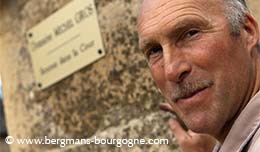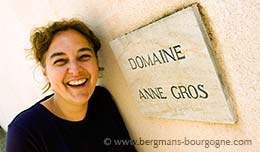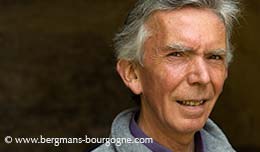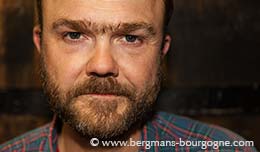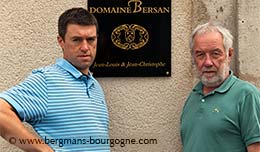
uring his 19 years at Domaine Maillard in Chorey-lès-Beaune Pascal Maillard has seen Burgundy survive a crisis and come out on top. But the real challenge still lies ahead of them, he thinks. They now need to establish a more uniform level of quality within each appellation.
– We have improved a lot, he says, but we need to improve more. A consumer may buy a bottle of Chorey, and then the next day another bottle of Chorey, but not by the same producer. It may not be the same quality and that is a little disturbing for the consumer. I believe that we have to improve quality; create a minimum level of quality.
Today the name of the producer is very important in Burgundy, more so than anywhere else in the world. Take two bottles of Corton for instance. Both will have the name Corton and the words grand cru on the label, but it is the producer's name that makes the difference. For the uninitiated this of course makes life a little complicated.
Considering the number of vignerons in Burgundy it does not sound altogether easy to make all pull in the same direction. The question is whether all agree on this strategy.
– It differs, Pascal Maillard smiles diplomatically. But they will have to do it. Only good wine will sell. There is a small arrière-garde that doesn't agree, but most do. The négociants for example will only buy the good grapes. If the producer doesn't keep the quality they will stop buying. The competition is good. You have to get better or you are gone.
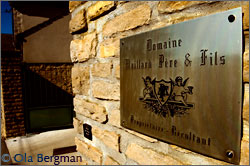
Pascal Maillard comes from a long tradition of vignerons. It goes all the way back to 1766. But it wasn't till 1952 that Domaine Maillard was founded, by Pascal's father Daniel. Up until then it had been a mix of viticulture and agriculture, but Daniel Maillard decided to create a domaine and go for wine only.
– My grandfather died when my father was six years old, so my father was raised by his mother. At twelve he had decided what he wanted to do with his life.
He was good at foreseeing things and back then, in the 1950's, he thought it would be better to become a wine grower than a farmer and he felt that the time was right to stop running a mixed enterprise.

Daniel Maillard started out with one hectare of vines. The 1950's and the 1960's were periods of expansion and today Domaine Maillard covers 19 hectares. At the same time Pascal's father did a lot of planting, which means that today much of the domaine's land consists of 30 to 50-year-old vines.
– Our 19 hectares are spread over seven villages – Chorey-lès-Beaune, Savigny-lès-Beaune, Beaune, Aloxe-Corton, Pommard, Meursault and Ladoix. All is Côte de Beaune.
In total Domaine Maillard makes twelve wines – three white and nine red – from village level up to grand cru. The favourite appellation changes depending on the vintage, but Pascal Maillard admits to having a soft spot for Chorey-lès-Beaune.
– It is not too expensive, but still very good. It is a wine you can play with. For the new consumer it is a good introduction the Burgundian wines. It is a good place to start. It is easier to experiment on the village level; you have a little more freedom. With grand or premier crus you have to respect the terroir.
In recent years the interest for the lesser known villages has grown. Pascal Maillard explains that it has become easier to sell Chorey-lès-Beaune, especially to younger people. But it is important to have good price/quality ratio.

– This appellation is not well-known. You have to educate people all the time. Put a Corton on the wine list and it is sold, put a Chorey and people say "What's that?".
– Chorey is more well-known in other countries than in France. It is a little extra that you have on the wine list, because people are looking for something new all the time. As they don't know Chorey and Savigny it is something new to them. It is kind of exotic and people are happy to try wines that they are not familiar with.
And if the basic red Chorey-lès-Beaune counts as exotic Domaine Maillard can offer something even more exotic – a white Chorey-lès-Beaune. Of all the produce in Chorey only a fraction is white. The total area under production is 136 ha. Chardonnay only accounts for a mere 5 ha. Most of the chardonnay vines can be found in the lieu dit Aux Clous, right by the roundabout by the Paris-Lyon motorway. In Domaine Maillard's case the vines are spread over four plots, basically one in each corner of the commune. All are rich in minerals, which is important for a wine like this. A white Chorey-lès-Beaune should be enjoyed in its youth, two to four years after the vintage.
– You can keep it longer, says Pascal Maillard, but it will not add anything to the wine.
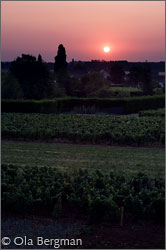
Former French president Jacques Chirac is one of the customers who has been buying the Chorey-lès-Beaune – both rouge and blanc – regularly.
It was not until the late 1980's that they began to bottle their own wines. When Pascal Maillard joined the family business they felt that the time was right to move on. Then seven or eight years ago it was time for another major decision; it was time to consider the export market.
– At the time the French market was good, but we felt that it would not stay like that forever. Today we are exporting 60 percent of our production to the US, Japan, Canada and Europe.
During his years at Domaine Maillard Pascal Maillard feels that Burgundy has undergone major changes. The competition from other countries, especially from the New World, has definitely had an impact. Burgundy has been forced to reconsider many things.
– 19 years ago it was so easy to sell wine. We just had to wait for people to come and we made the wines exactly the way we wanted, not thinking about the consumers' taste. We said "If you don't like it, then there are others outside waiting for it".
That attitude did not survive. Burgundy had a look at its weaknesses and strengths. The important thing was to find a balance between the region's terroir and what people wanted from a wine.
– The crisis had a good impact. We did not loose our personality. We never will, because it is what makes us different. Everybody in the world is doing some chardonnay and pinot noir nowadays.
© 2007 Ola Bergman










